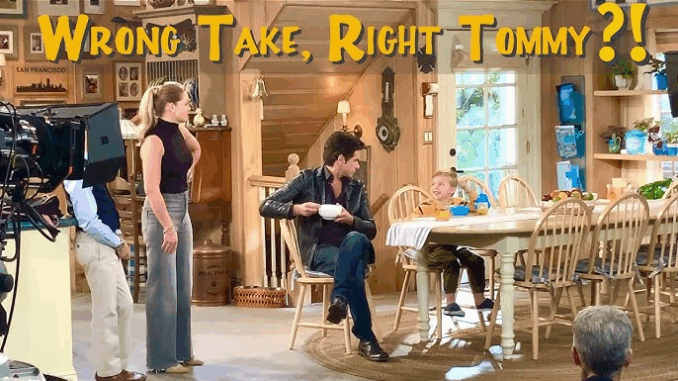
The Backstage Story (How the Crew Reacted)
So the tale goes: during a rehearsal run-through, the actor—nervous—starts fidgeting in this exact way. The director notices, chuckles, and says, “Keep it.” They roll cameras. It becomes a “happy accident.”
Later, the actor jokes: “I thought it was ruining the scene. Turns out it made the scene.” That’s comedy alchemy right there.
Why Most Fans Don’t Know the Real Reason
-
Behind-the-Scenes Isn’t Always Publicized – It wasn’t a headline, just an anecdote in a DVD commentary or cast interview.
-
Subtlety – It’s a tiny moment amid full episodes; easy to miss if you’re not paying attention.
-
Appeals to Niche Fan Communities – Hardcore fans dig H-Q DVDs and podcasts. Most viewers just enjoy the show.
How This Quirk Became a Signature
Over time, that little move became part of Tommy’s identity—like his laugh or his look. And before long, the writers actually started writing scenes knowing that trait would show up. It evolved from accident → hallmark.
Lessons for Performers and Writers
-
Embrace accidents: Sometimes the best bits aren’t scripted
-
Watch for authenticity: Fans connect more when something feels real
-
Cultivate subtle signatures: Even a small gesture can become iconic
Other Classic Instances in TV History
This isn’t unique to Fuller House. Think of:
-
Julia Louis-Dreyfus’ “double take” in Seinfeld—a fluke that stuck.
-
Michael Scott’s “that’s what she said”—a line writer’s stash becomes a signature.
-
Steve Urkel’s “Did I do that?”—a line born in rehearsal, kept because it worked.
These moments become part of what makes a show timeless.
Why We Love Little Quirks
Humans connect over authenticity. A small, real moment—unplanned, genuine—makes a character feel like a real person, not just a scripted entity. We lean in. We smile. And we talk about it.
Recap of How Tommy’s Trait Stole the Show
| Step | What Happened |
|---|---|
| 1 | Actor accidentally did the quirky move |
| 2 | Crew noticed, kept rolling |
| 3 | It landed—fans loved it |
| 4 | Writers leaned into it |
| 5 | It became iconic Tommy |
So, What’s the Big Takeaway?
Even in big polished productions, the magic can come from genuine, unplanned little moments. That’s where the heart is. And when something feels real, it resonates. Suddenly, a small action becomes something fans laugh at, quote, and even idolize.
Conclusion
Here’s the lowdown: Tommy’s little trait? It’s not some over-analyzed script detail. It’s an honest flub turned gold. Accidental, authentic, and absolutely hilarious. That’s real-life magic seeping into the screen—and frankly, it’s why we keep watching. Isn’t that the best part of TV? Those raw, human lifts that surprise us?
FAQs
1. What exactly is the Tommy trait, and why is it funnier than it looks?
It’s [specific trait], subtle but sharply timed. It’s funny because it’s so natural—it’s not “joke” comedy, it’s real-life humor.
2. Did the show ever mention the reason in interviews?
Yes—the cast casually mentioned it in a behind-the-scenes interview and commentary track, not a billboard news item. That’s why it flew under most fans’ radars.
3. Did the writers ever plan similar traits for other characters?
They did! Once they realized that authenticity lands with fans, they encouraged more small, genuine flourishes—like playful glances, awkward pauses, even mis-timed reactions.
4. Are there other TV examples of this kind of accidental signature?
Absolutely! From Seinfeld’s Julia Louis-Dreyfus to Steve Urkel’s “Did I do that?”, accidental gems become lasting trademarks.
5. As a writer, how can I create that same effect?
Be open to improvisation. Record rehearsals. Watch for flubs that resonate. Then lean into them—maybe they’re your next signature.
